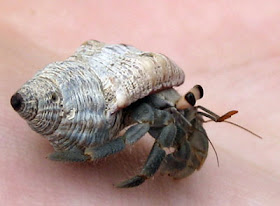Blue Crab
The Blue Crab has an olive green to brown body with points on each side. The underside of the blue crab is white. The crab gets its name from the brilliantblue colored claws and legs. The tips of the claws are red or orange and can be used to determine the sex of the crab. Males have red or orange coloration only at the very tips, while the red or orange in females covers more of the claw.
Lady Crab
The Lady Crab is a small, rounded crab with a collection of red and purple calico spots. The markings serve as a camouflage both to defend against predators and to help them ambush their primary prey, small fish. Found on the sandy shoals just offshore, the Lady Crab often buries itself, leaving just its eyes and antennae exposed.
Speckled Crab
This crab is identified by the large number of white dots on its brown to olive shell. The Speckled Crab has a flat shell with points on both sides, similar to the Blue Crab. Like most swimming crabs, their body design works just as well for digging as it does for swimming. Their coloration helps them blend in with the sandy sediments. Speckled Crabs are often found in tide pools.
Walking Crabs
Walking crabs get their name because all of their legs end in points. Because these crabs can not swim, they navigate the ocean and river bottom using their 4 matching pairs of legs. Walking crabs shells are generally more dome-shaped than those of swimming crabs.
Ghost Crab
These land-dwelling crabs can be seen scurrying quickly (up to 10 mph) along the beach between dusk and dawn. Ghost Crabs have 1.5- to 2-inch square, beige colored bodies that allow them to “disappear” into the sand. Mainly a land crab that burrows in the dry sand, Ghost Crabs wet their gills at the water's edge and the females enter the ocean to lay eggs in the salt water. While not very large, Ghost Crabs can prey on sea turtle hatchlings. They also eat coquina clams and flying insects that they catch in mid-air.
Spider Crab
This crab looks like a large spider with a bumpy brown, pear-shaped body and long legs. Spider Crabs are often found on mud bottoms, clinging to marsh grasses, or riding along on Cannonball Jellyfish. A Spider Crabs rough shell collects bacteria and plankton. This coating encourages the growth of other plants and animals on the shell surface. Nicknamed the “decorator crab,” Spider Crabs use this coating to disguise themselves. The shell decorations also are a source of food for the crab.
Stone Crab
Growing to over 5 inches across with massive claws, the Stone Crab is prized for its meat. Care must be taken, however, because the massive claw of an adult Stone Crab can easily crush the finger of an inattentive crabber. Because of their slow growth rate, only the larger of the two claws is taken at harvest. The crab is returned to the water where the missing claw will regenerate. Stone Crabs are purplish-tan in color with a thick oval body and black “finger tips” on the claws.
Hermit Crab
Hermit Crabs are unusual in that their hard outer shell covers just their head and claws, not their entire bodies like other crabs. To protect their fragile bodies, Hermit Crabs find and move into empty snail and whelk shells. Their bodies are specially designed so that their two back pairs of legs hook into the protective shells. They cannot be removed without destroying the animal. Hermit Crabs found on Kiawah are not the same as those sold in pet stores. Our local Hermit Crabs live in salt water and cannot survive out of the water for a prolonged period.
Marsh Crabs
Two types of marsh crabs are found on Kiawah. The first species, the Wharf Crab (also known as the Grey Marsh Crab, Square-Back Marsh Crab, or Friendly Crab) is found in the higher marsh areas and bordering regions. When you are out for a stroll, these small, dark-colored crabs with square, flattened shells often surprise you by darting across the bike path or beach access. The other species is the Marsh Crab, or Purple Marsh Crab, which prefers the lower areas of the marsh where it constructs a burrow with a mud “chimney.” It has a square body like its relative the Wharf Crab, but has a thicker body. As the name implies, the coloration of the Marsh Crab is typically purple and they are often mistaken for young Stone Crabs. However the tips of the Marsh Crabs claws are light-colored and their legs are “fuzzy."
Fiddler Crabs
Fiddler crabs occur in both sandy and muddy environments and are very common along creeks and mud flats around Kiawah. The male Fiddler Crabs large, white claw is unmistakable. Males are typically seen waving this claw back and forth in a territorial display. Females in habit the same areas as males, but are often harder to spot since they lack a large, bright-colored claw. The male uses his single smaller claw (and the female uses her two small claws) to scrape up mud and sediment for food. They are excellent burrowers and their holes can sometimes extend down more than 2 feet. These burrows have an added benefit of aerating the marshes and preventing the “rotten egg” smell associated with some saltwater marshes.
Crabbing
Crabbing is a popular activity on Kiawah Island. A simple crabbing set-up consists of string, a chicken neck for bait, and a long-handled net for scooping the crabs up. Remember, blue crabs must be more than 5 inches across the back, tip to tip, to keep. One of the best places to crab on the island is the Kiawah River Bridge.










No comments:
Post a Comment